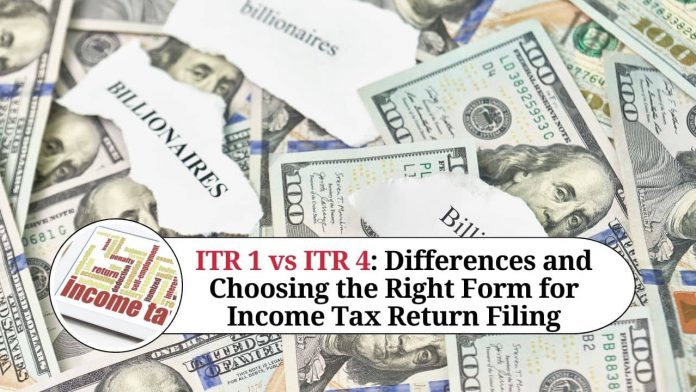Introduction
Income Tax Return (ITR) is a form that taxpayers in India file to report their income and pay taxes to the government. There are various types of ITR forms, depending on the source and amount of income earned. In this blog, we will discuss two of the most commonly used ITR forms – ITR 1 and ITR 4.
ITR 1
ITR 1 is also known as Sahaj Form, and it is the simplest ITR form that individuals can use to file their income tax return. It is applicable to individuals who have earned income from the following sources:
- Salary or Pension
- One house property
- Other sources such as interest on bank deposits, etc. (up to INR 10,000)
ITR 1 is not applicable if the individual has:
- More than one house property
- Capital gains
- Income from business or profession
- Income from agriculture above INR 5,000
- Foreign assets or income
ITR 4
ITR 4 is also known as Sugam Form, and it is applicable to individuals and Hindu Undivided Families (HUFs) who have income from a proprietary business or profession. It is also applicable to individuals who have opted for the presumptive taxation scheme under Section 44AD, Section 44ADA or Section 44AE of the Income Tax Act. ITR 4 is applicable if the individual has income from the following sources:
- Proprietary business or profession
- Salary or Pension
- One house property
- Other sources such as interest on bank deposits, etc. (up to INR 10,000)
ITR 4 is not applicable if the individual has:
- Income from more than one business or profession
- Income from speculative business or profession
- Income from agency business or commission
- Income from salary or pension above INR 50 lakh
- Income from foreign sources or foreign assets
- Income from racehorses or lottery
Differences between ITR 1 and ITR 4
- Applicability: ITR 1 is applicable to individuals who have income from salary or pension, one house property, and other sources up to INR 10,000. On the other hand, ITR 4 is applicable to individuals and HUFs who have income from a proprietary business or profession, salary or pension, one house property, and other sources up to INR 10,000.
- Income sources: ITR 1 is suitable for individuals with income from salary or pension, one house property, and other sources. However, ITR 4 is suitable for individuals with income from a proprietary business or profession, salary or pension, one house property, and other sources.
- Number of house properties: ITR 1 is not applicable if an individual has more than one house property. However, ITR 4 is applicable even if an individual has more than one house property.
- Capital gains: ITR 1 does not apply if an individual has capital gains. However, ITR 4 is suitable for individuals with income from capital gains.
- Presumptive taxation scheme: ITR 4 is applicable to individuals who have opted for the presumptive taxation scheme under Section 44AD, Section 44ADA or Section 44AE of the Income Tax Act. However, ITR 1 is not applicable if an individual has opted for the presumptive taxation scheme.
It is also essential to maintain proper records and documentation of all income sources, deductions, and investments made during the financial year. This will help in the accurate filing of income tax returns and reduce the chances of errors or discrepancies.
Another point of consideration when filing ITR 1 or ITR 4 is the requirement for audit. While ITR 1 does not require any audit, ITR 4 may require an audit if the total turnover of the business exceeds INR 2 crore in a financial year. In such cases, the individual may have to get their accounts audited by a chartered accountant and file the audit report along with the ITR 4.
Additionally, it is important to keep in mind that ITR 1 is only applicable to resident individuals, while ITR 4 can be filed by both resident individuals and Hindu Undivided Families (HUFs).
It is also worth noting that both ITR 1 and ITR 4 can be filed online through the Income Tax Department’s e-filing portal. Online filing of ITR has many advantages such as faster processing, reduced chances of errors, and the ability to access past records easily.
Apart from the differences in eligibility and requirement for audit, there are other notable differences between ITR 1 and ITR 4. For instance, ITR 1 has a simplified structure and is relatively easy to fill, while ITR 4 is more detailed and requires more information about the business or profession. This is because ITR 4 is designed for individuals who have income from a proprietary business or profession, and hence, it requires additional information such as details of partners and capital accounts.
Another key difference is in the way income is computed. ITR 1 follows a more straightforward approach, where income is computed by adding all income sources and subtracting deductions. In contrast, ITR 4 follows a presumptive taxation approach, where income is calculated based on a percentage of the total turnover or gross receipts of the business or profession. This approach is intended to simplify tax compliance for small businesses and reduce the burden of record-keeping and accounting.
Finally, it is important to note that filing ITR 4 requires individuals to maintain proper books of accounts and keep track of all business transactions. This can be a time-consuming and challenging task, especially for individuals who do not have prior experience in accounting or bookkeeping. In such cases, it is advisable to seek the help of a professional accountant to ensure accurate and timely filing of ITR 4.
Conclusion
In conclusion, while both ITR 1 and ITR 4 are used for filing income tax returns, they differ in eligibility, audit requirements, structure, computation of income, and record-keeping. It is important for individuals to understand these differences and choose the appropriate form based on their income sources, business or profession, and level of accounting expertise.
Read more useful content:
- How to Save Tax on Salary
- Guide to Understanding Direct Taxes in India
- Filing Income Tax Returns
- GST E-invoice
Frequently Asked Questions (FAQs)
Q1.) Who can file ITR 1 and ITR 4 forms?
ITR 1 is applicable to resident individuals with income up to INR 50 lakh, while ITR 4 is applicable to resident individuals and HUFs with income from a proprietary business or profession.
Q2.) Can an individual with income from a salaried job and rental income file ITR 1?
Yes, an individual with income from a salaried job and one house property can file ITR 1.
Q3.) What is the due date for filing income tax returns?
The due date for filing income tax returns is usually July 31st of every year.
Q4.) Can I file my income tax returns online?
Yes, income tax returns can be filed online through the Income Tax Department’s e-filing portal.
Q5.) Do I need to get my accounts audited for filing ITR 1?
No, accounts audit is not required for filing ITR 1.
Q6.) What is the presumptive taxation scheme?
The presumptive taxation scheme is a simplified taxation approach under which individuals with income from a business or profession can pay taxes based on a percentage of their total turnover or gross receipts.
Q7.) Can I file ITR 4 if my business turnover exceeds INR 2 crore?
Yes, you can file ITR 4 if your business turnover exceeds INR 2 crore, but you may have to get your accounts audited.
Q8.) Can I claim deductions in ITR 4?
Yes, you can claim deductions in ITR 4, but you need to maintain proper books of accounts and record all business transactions.
Q9.) What happens if I miss the due date for filing income tax returns?
Missing the due date for filing income tax returns can result in penalties and interest on tax dues.
Q10.) Can I revise my income tax returns if I make a mistake?
Yes, you can revise your income tax returns within a specified period if you make a mistake or need to update any information.




















